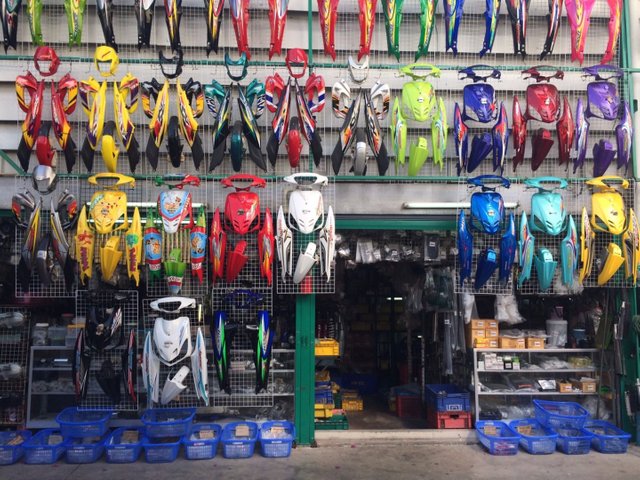Recognizing the Important Parts of a Motorbike: A Comprehensive Overview for Enthusiasts
For motorcycle lovers looking to raise their riding experience and guarantee their bikes run efficiently, understanding the essential components of a motorcycle is critical. Each aspect, from the engine's detailed operations to the crucial function of the braking devices, not just impacts efficiency yet additionally safety and security and convenience.
Engine Parts

The camshaft plays a critical function in managing the timing of the engine's valves, ensuring the exact opening and closing necessary for effective gas and air intake, along with exhaust expulsion. This timing is crucial to keeping optimal engine performance and effectiveness. In addition, the carburetor or fuel shot system, depending upon the bike model, is accountable for blending air with gas in the correct ratio for combustion.
The cooling system, either air or liquid-based, functions to keep the engine's temperature level within functional limits, protecting against overheating and making sure durability - mx gear nz. Each element, meticulously made and integrated, adds to the seamless operation of the engine, specifying the motorbike's power result and total efficiency
Transmission System
Integral to the motorcycle's capability, the transmission system ensures effective power transfer from the engine to the wheels. This system makes up several important parts, consisting of the clutch, transmission, and final drive, each playing an important function in translating the engine's power into movement. The clutch, typically operated by a hand bar, offers to involve and disengage the engine from the transmission, enabling smooth equipment adjustments and controlled velocity.
The gearbox, typically referred to as the transmission correct, consists of a collection of gears that bikers can manually move with to change the bike's speed and torque output. These gears are prepared in a sequence that allows the bike to speed up smoothly and preserve optimal engine performance across numerous rates. The majority of motorcycles utilize a sequential gearbox, calling for the motorcyclist to move equipments in a fixed order.
Braking Mechanisms
While recognizing the transmission system is crucial to using a motorbike's power, just as crucial is the capability to control and quit that power properly, which is where stopping systems enter into play. Brakes are vital for safety and performance, giving the motorcyclist with the required control to navigate different surfaces and problems. Commonly, bikes include two sorts of braking systems: disc brakes and drum brakes.
Disc brakes are more prevalent in contemporary bikes due to their remarkable efficiency. This system offers better heat dissipation, constant performance, and enhanced quiting power, specifically in damp conditions.
Conversely, drum brakes, though less typical, are still discovered in some bikes. They work by pressing brake shoes versus the internal surface of a drum affixed to the wheel. While generally less efficient in warmth dissipation and quiting power, drum brakes are easier and more cost-efficient.
Understanding these braking systems' subtleties allows bikers to preserve their motorbikes correctly and appreciate the engineering that makes sure risk-free and effective quiting.
Suspension and Guiding
Suspension and steering systems are important elements that significantly affect a motorcycle's news handling and experience comfort. The shock absorber, consisting of forks at the front and shock absorbers at the rear, absorbs roadway irregularities, enhancing security and control. Front forks, commonly telescopic or upside down, compress and rebound to reduce effects, while rear shock absorbers maintain tire call with the roadway, essential for traction and safety.
Steering, centered around the handlebars, connects the cyclist to the bike's directional control. The guiding head bearings make certain smooth operation, allowing precise ability to move. Proper positioning and maintenance of these bearings are essential for predictable steering response and reducing cyclist exhaustion.
The suspension's adjustability is another critical facet; preload, damping, and rebound setups enable customization to match various riding styles and problems. This adaptability is essential for maximizing efficiency, whether navigating city streets or dealing with tough trails. Technologies like digital suspension systems offer real-time adjustments, boosting trip top quality throughout diverse surfaces.

Electric Systems
After making sure a smooth and regulated ride via effective suspension and steering systems, attention transforms to the electrical systems, a crucial element of contemporary motorbikes. These systems play a critical role not just in starting the engine however also in powering different elements that enhance the performance and security of the bike.
At the heart of a motorbike's electric system is the battery, which stores electrical energy required for beginning the engine and powering complementary systems - motorcycle shop. The generator or generator, combined with the rectifier-regulator, ensures the battery continues to be click to read more billed while the motorcycle is in procedure, converting mechanical power into electrical power and maintaining voltage degrees
The ignition system, another critical component, is liable for stiring up the air-fuel mixture in the engine's cylinders. Modern motorcycles frequently use a digital ignition system, offering higher performance and reliability compared to conventional systems.
Lights systems, including headlights, tail lights, and indicators, are also important, guaranteeing exposure and security for the cyclist. Extra electronic parts such as sensors, control devices, and presents add to sophisticated attributes like gas injection administration, anti-lock stopping systems (ABDOMINAL MUSCLE), and digital dashboards, further improving the riding experience.
Final Thought
A thorough understanding of a motorbike's necessary parts, including the engine, transmission system, braking systems, suspension, guiding, and electrical systems, is crucial for lovers intending to maximize security, comfort, and efficiency. Proficiency of these elements enables notified decisions regarding upkeep and upgrades, eventually enhancing the riding experience. By integrating this understanding, motorcyclists can guarantee their motorbikes run at peak efficiency and reliability, consequently maximizing both pleasure and longevity of their cars.
For bike fanatics looking to boost their riding experience and ensure their bikes run smoothly, comprehending the crucial elements of a motorbike is helpful hints paramount.Integral to the motorbike's performance, the transmission system ensures effective power transfer from the engine to the wheels.While recognizing the transmission system is essential to harnessing a bike's power, just as important is the capability to regulate and stop that power successfully, which is where braking systems come into play. Commonly, motorcycles feature two kinds of braking systems: disc brakes and drum brakes.
A comprehensive comprehension of a motorbike's important components, including the engine, transmission system, stopping mechanisms, suspension, steering, and electrical systems, is crucial for fanatics aiming to enhance performance, safety, and convenience.